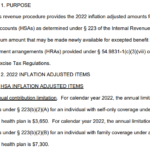The IRS has released the official 2026 limits for HSA contributions and High Deductible Health Plans (HDHPs). As expected, the limits have gone up again in response to inflation and rising healthcare costs, but this year’s changes come with a twist.
Due to the Big Beautiful Bill, which passed earlier this year, all Bronze and Catastrophic plans in 2026 will be HSA-qualified by default. That’s a major shift from previous years, when only a handful of plans met the IRS rules for HSA compatibility.
2026 HSA Contribution Limits:
- Self-Only: $4,400 (up from $4,300 in 2025)
- Family: $8,750 (up from $8,550 in 2025)
And if your employer offers an Excepted Benefit HRA (usually for things like dental and vision), the 2026 max will be $2,200.
If you’re 55 or older, you can also make a $1,000 catch-up contribution on top of the standard limit. If both spouses are over 55, each person can make their own catch-up, but you’ll need separate Health Savings Accounts to do that. You can’t combine both contributions into one account.
What the Big Beautiful Bill means for HSA plans in 2026
One of the biggest changes under the new law is that HSA-qualified plans no longer need to meet a lower out-of-pocket max than ACA plans. That’s a major simplification, and it removes the main reason HSA plans used to be more expensive than regular Bronze plans.
In past years, insurers had to stop cost-sharing at lower levels for HSA plans (e.g., $8,750 for an individual) than what ACA plans allowed (up to $9,900). That extra coverage meant HSA plans often had higher premiums, even though they had “high deductibles.”
But now, starting in 2026, HSA plans and regular Bronze and Catastrophic plans are on equal footing. If you’re looking for a low-premium plan and want to take advantage of tax-free savings, you don’t have to compromise anymore. Most Bronze plans will be HSA-compatible, giving you more flexibility, and more plans to choose from.
These updates come from IRS Revenue Procedure 2025-26.
If you’re not sure whether an HSA plan fits your needs, whether you’re looking to reduce taxable income, save for future medical expenses, or just want peace of mind, feel free to reach out. We’re happy to help you compare your options and find a plan that makes sense for your life.



